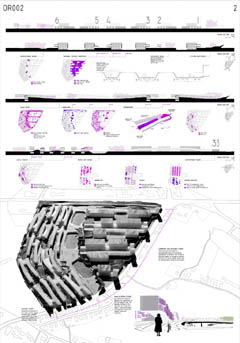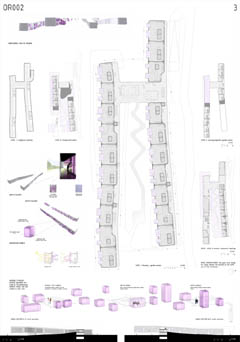AMSTETTEN
1. first prize: "free space as the urban gene"
associates: Jose Antonio MARTIN SOTO (E)
"The proposal consists of a flexible development concept organizing the trade part on the Landeswiese plot in the form of stripes, and the housing part by varying and distributing an already differentiated basic type: “Housing Cromosome with Centromere”. The strength of the proposal lies in its intelligent vertical organization: the accesses for commercial vehicle traffic have been conceived as lowered cul-de-sacs leading to large lowered surfaces – oversized turnaround areas acting as public function areas. Thus, housing and trade functions can be separated from each other in an attractive manner and simultaneously public programs can be integrated in such a way that they accentuate the identity of the Landeswiese. This “programmed void” also allows leeway in defining the boundary between housing and trade functions. This gives the community and the landowners a flexible strategy which defines qualities in a very precise manner. Should the proposal be implemented, these qualities must be taken into consideration: a differentiated vertical development, development of the lowered public spaces, a condensed organization of the trade area (and a coupled development of both uses in some parts).
The project strategy with its vertical development concept is also maintained in the housing and used to define transparencies, public areas and collective platforms within the individual U-shaped housing blocks. The jury regrets that the Landeswiese housing development concept is also used for the Rauschergründe plot: despite the fact that the general development (with a clear stripe in the middle of the development) was adapted to the Rauschergründe, the individual framework conditions of that plot were not taken into account sufficiently.
The architectural formulation of this development is considered too diagrammatic and too schematic, as can be observed in the hotel project on Landeswiese, where the “Cromosome” type comes up against its limitations.
Regarding implementation, the jury recommends pursuing the basic organizational principles of differentiation, multi-stage transitions between private, semi-public and public areas. However, these principles should express themselves in architecture in a richer way than is displayed in the competition project."
(Excerpt jury report)
"Das Projekt zeigt ein flexibles Entwicklungskonzept, das den Gewerbeteil auf der Landeswiese bandartig organisiert und die Wohnbebauung über die Variation und Verteilung eines differenzierten Grundtypus – „Housing Cromosome with Centromere“ – entwickelt. Die Stärke des Projekts liegt in der Intelligenz der vertikalen Organisation: die Zufahrten des Gewerbelastverkehrs werden als abgesenkte Sackstraßen konzipiert, die in großen, versenkten Freiflächen – überdimensionalen Umkehrpunkten, die als öffentlichen Bespielungsflächen fungieren – enden. Damit gelingt eine attraktive Trennung zwischen Wohn- und Gewerbefunktionen, die gleichzeitig öffentliche Programme aufnehmen kann und zur Identität der Landeswiese beiträgt. Diese „programmierte Leere“ erlaubt auch ein Spielraum in der Definition der Grenze zwischen Wohnen und Gewerbe. Die Gemeinde und Grundstücksbesitzer erhalten damit eine flexible Strategie, die gleichzeitig präzise Qualitäten festlegt. Im Falle einer Umsetzung des Projektes müssten diese Qualitäten unbedingt berücksichtigt werden: die differenzierte Vertikalentwicklung, die Entwicklung der abgesenkten öffentlichen Flächen, die verdichtete Organisation der Gewerbeentwicklung (teilweise gekoppelte Bebauung).
Die über die Vertikalentwicklung agierende Entwurfsstrategie wird in der Wohnbebauung fortgesetzt, um Durchlässigkeiten, siedlungsbezogene Freiräume, öffentliche Bereiche und kollektive Plattformen innerhalb der einzelnen U-förmigen Wohnblocks zu definieren. Die Jury bedauert, dass die Wohnbebauung der Landeswiese ebenso auf den Rauschergründen verwendet wird: trotz einer Abwandlung der Gesamtbebauung auf den Rauschergründen (Freiraumband in der Mitte der Besiedelung bleiben die unterschiedlichen Rahmenbedingungen der Grundstücke zu wenig berücksichtigt.
Die architektonische Ausformulierung dieser Bebauung erscheint zu formal und schematisch, was sich vor allem bei der Entwicklung des Hotels auf der Landeswiese zeigt: hier stößt der Cromosome-Typus eindeutig an die Grenzen seiner Möglichkeiten.
Für die Umsetzung empfiehlt die Jury, die organisatorischen Grundprinzipien, welche differenzierte, mehrstufige Übergänge zwischen privaten, siedlungsorientierten und öffentlichen Räumen aufweisen, als Prinzip in jedem Fall weiter zu verfolgen. Dieses Prinzip müsste allerdings architektonisch vielfältiger realisiert werden, als es das Projekt im Wettbewerb vorgibt."
(Auszug Juryprotokoll)



